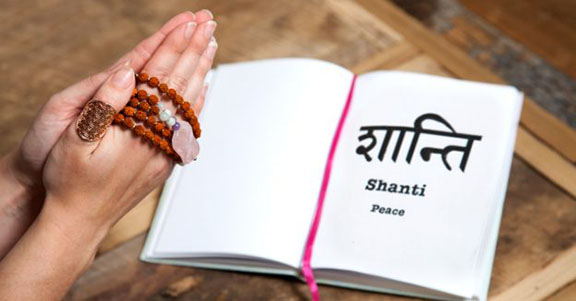 Japa, the practice of repetition of a mantra, focuses the mind, makes it one-pointed and leads it into meditation. In this calm state, the powerful forces which are stored up in the unconscious get released and raised up to the conscious or subconscious level. The same revelations or realizations experienced by so many great souls are lying dormant within every one of us. When these are awakened by japa and meditation, the result is the condition of expanded awareness.
Japa, the practice of repetition of a mantra, focuses the mind, makes it one-pointed and leads it into meditation. In this calm state, the powerful forces which are stored up in the unconscious get released and raised up to the conscious or subconscious level. The same revelations or realizations experienced by so many great souls are lying dormant within every one of us. When these are awakened by japa and meditation, the result is the condition of expanded awareness.
A mantra is a sound structure of one or more syllables which represents a particular aspect of the divine vibration. Sages in deep meditation heard these sounds while experiencing some aspect of the Truth or God. Mantras have been handed down through generations of spiritual masters as guides to aspirants.
Concentrated mental repetition of the mantra produces vibrations within the individual’s entire system which are in tune with the divine vibration. Practicing with a mantra is a simple but very efficient and direct approach. It is a method which utilizes sound vibrations. As we all know, the entire creation is nothing but sound vibrations. “In the beginning was the Word. The Word was with God. The Word was God,” the Bible says. Every scripture says something similar. The unmanifested essence of God is static, but with creation it begins to vibrate. That cosmic vibration is called the pranava.
Pranava means a humming sound. That hum is called the Word or the sound and it is expressed vocally by the OM or Amen or Ameen. However, the real OM is not even spoken; it is to be felt within in deep meditation as the humming of the cosmic vibration. This hum vibrates at different levels and gives rise to different forms, because sound vibrations create forms, Even science says that. We and everything else in the universe are nothing but sound vibrations in different wave lengths. Every particle vibrates because there are atoms in it filled with the movement of electrons and protons,
To commune with this cosmic sound is to have communion with what the different religions call God. Call it any way you want, communion with God, or Yoga (union) with God or union with Nature. To have this communion, you have to vibrate in the same wave length as the cosmic sound vibrates. You have to become a radio receiver and tune yourself to that wave length. It is to effect this tuning that the mantra is repeated, first vocally, later silently with lip movements, and in an advanced stage, completely mentally. When the tuning is complete, the energy flows into you and you get the divine music.
Hari OM Mantra
OM is the basic vibration. It vibrates every cell in your body and brings peace. OM creates a special rhythm in your system. You are sent into an ecstatic mood just by chanting OM. Of course, when you add “Hari” (“Ha” pronounced as the “ho” in hot, “Ri” as the “re” in repeat), you get an added effect. Hari is another name for the Absolute. It means “the one that removes all obstacles, the one that purifies the entire system.”
Repeating the word Hari makes you do a particular type of pranayama or breathing exercise. Each syllable has its own significance. The first syllable, “Ha” requires a contraction of the solar plexus. It creates a kind of Kapalabhati or bellows-breathing vibration and it ignites the vast storehouse of physical and emotive power at the solar plexus. In pronouncing “Ri” the system relaxes, and the throat contracts to make the force more concentrated. “Ri” brings in a special kind of heat.
Then for “O” the throat opens and the energy or sound rises upward from deep within the chest. With the prolonged “Mmm,” the mouth closes and the energy goes to the head with a strong humming vibration’. So Hari accelerates the system first and the OM takes you to a higher level.
Repeat Hari Om in a monotone, for as long as you feel comfortable. You can vary the pitch, speed and intensity according to the condition of the mind and eventually let the voice flow into silent repetition. After some time, just sit quietly and see how you are and what you feel.
OM Shanti
Shanti (Peace) is the nature of God. I see God as Shanti. God has no form and no other name. God is all peaceful. God is all serenity. It is to be felt; it is to be experienced within one’s self. When you are in Peace, you are in God. You are with God.
Practicing Mantra Meditation
Sit comfortably with the entire weight of the body supported by the straight spine. Observe your breathing, slowly making it deeper and deeper. Take long, slow, deep breaths, carefully observing the flow of the air in and out. Follow the breath as it goes in; feel that it goes right through the spinal column to the base of the spine and then returns upward to the crown of the head when you exhale. After doing this a few times, let the breath flow in and out by itself without using any force. After watching the breath for a few minutes, mentally repeat OM with the next incoming breath. Let the air flow in with the OM sound and when it comes out, let it say Shanti. Do not consciously do the breathing, but just be conscious of the breath and combine it with OM Shanti. Imagine the air flows in saying OM and rolls out with Shanti. You need not repeat it, just feel it.
This technique can be used with your own personal mantra or any mantra of your choosing. Combine the mantra with the breath in any way that is comfortable for you—splitting the mantra between the incoming and outgoing breath, or one repetition with the inhalation and another with the exhalation. If you watch carefully, you can not only feel the air saying the chant or mantra, but you can listen to that.
That needs complete attention, an indrawn mind. All through, keep the spine erect so that the flow will be easy. Let the OM breath go deep to strike at the base of the spine, and then with Shanti let it roll upward through the spine to the crown of the head. Thus you will be feeling the air, or the breath, going in and out or downward and upward along the spine without its even flowing outside—you should try not to feel the air flowing outside through the nostrils but along the spine.
In the beginning, if you find it difficult to follow the breath up and down the spine in this way, then just follow the breath in and out of the body. After a few months’ practice, when you become comfortable with that, then begin to follow the breath along the spine.
Try to keep the entire mind on the breath and the chant. If you carefully observe the path along the spine, you will be able to feel a very mild heat, a gentle warmth, which is very pleasant. Try not to miss that; put the entire attention on it.
The purpose of this practice of following the breath along the spine is to become conscious of the psychic energy traveling along the spine, passing through certain spiritual centers called chakras. However, it is inadvisable to keep the mind focused on the lower chakras. If you become aware of a warmth there, feel it but don’t allow the mind to become fixed there. Bring the mind to one of the higher centers such as the heart or eyebrow center and draw the energy upward.
Continue to watch the breath, repeating OM Shanti for as long as you feel comfortable. Then, to come out of meditation, slowly increase the duration of the inhalation and the exhalation. Make the breath longer and feel the air flowing out through the nostrils. Inhale and exhale deeply a few more times.
Carry this peaceful feeling from meditation all through the day, all through the week, all through your life. Even in the midst of a busy life, you can retain this peace. Learn to do that, then it will make no difference whether you are in a church or a stock market.
You can be in peace, at ease. Then it’s only a matter of expanding—it’s limitless. May this peace and joy prevail in your life always.
 Mala Beads – An Additional Aid to Japa
Mala Beads – An Additional Aid to Japa
The Japa mala is a string of 108 beads with a mount bead called the meru. It is a physical aid to concentration. To use the mala, allow it to rest on your ring finger. Use the middle finger and the thumb to move the beads. Do not use the index finger. Let the meru be inside the moving fingers. Push the beads inward one at a time with each repetition. Upon reaching the meru, do not cross over it, but turn the mala around and start again. The mala helps you not to fall into laya or loss of awareness.


